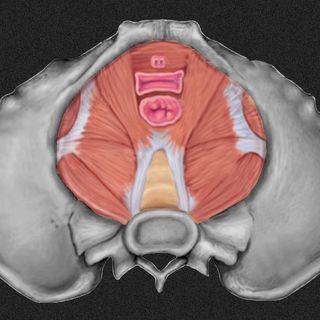
I Hate Yoga, But My New Obsession Is an Instagram Account About … Yoga
Dolly Singh makes yoga seem like a joy.

Dolly Singh is a delight. Her buoyant laughter bubbles through the phone in bright colors, painting her words in the sunny yellows, hot pinks, and sky blues of her Instagram photos. For a moment, it makes me forget all of my serious questions about yoga and fitness, and ask the one, completely irrelevant, lighthearted question I’ve been dying to know: Where did she buy her curtains?
“In Jaipur!” she chirps. “I’ve already ordered sheets [from the same place] because they’re so good.”
Singh’s colorful curtains feature in the background of most of her photos. The foreground features her — a yoga enthusiast who, for the past two years, has been posting about one photo a day of herself twisted into advanced poses. Not unusual, on a platform that spawned #bodygoals and #thinspo influencers, except for one thing.
“I defy all numbers. By numbers — BMI, weight — I am unhealthy. I understand that,” she says. “I’m supposed to be lazy, I’m supposed to have chronic diseases — but none of that is true.”
Singh has been celebrated by media outlets as a leading face of body positivity in India, but just two years after starting to learn yoga, and starting the Instagram account that documents that journey, it might be more accurate to call her a leading face of redefined health.
“Studies have found that anywhere from one-third to three-quarters of people classified as obese are metabolically healthy. They show no signs of elevated blood pressure, insulin resistance or high cholesterol. Meanwhile, about a quarter of non-overweight people are what epidemiologists call ‘the lean unhealthy,'” wrote journalist Michael Hobbs earlier this year, in a piece titled “Everything You Know About Obesity Is Wrong.”
Singh is one of these healthy people — not in spite of her curves, just in addition to them.
“I love to trek, I can go for mountainous treks. I love to run, I can do my 10 kilometer run,” she says. “If I go stand on a scale, I will feel unhappy. That’s the conditioning that has happened. … [But] in my vocabulary, if I take out the numbers, I feel okay with the way I am.”
Singh says she did not set out to be a role model or challenge body norms. She simply wanted to learn yoga, and a bad experience with a teacher set her on the path of self-instruction. She started her Instagram to track how her posture and body changed, improved, strengthened over time.
“I do understand visibility and acceptance, and I believe in that,” she says. Singh often photographs her poses wearing booty shorts and bra tops, but she says the clothes aren’t a statement about body positivity so much as they’re a choice that allows her to move freely and not swelter in the Mumbai heat. Still, she says, “people who come to me trust me in a very different way.”
Part of that may come from Singh’s interest in changing the perception of yoga more than any perceptions of herself. She says she favors photos that don’t show her face, so the focus is on her posture; she doesn’t pay for social media promotions. Her posts often feature a hack or aid — a block, cushion or belt that helps her achieve her contortions — that challenge a purist’s practice.
“When you go to a yoga class for the first time, you think flexibility and strength is a requirement for doing yoga. But it’s a function of doing yoga over a period of time,” Singh stresses.
She launches into what feels almost like a mantra, sales pitch and definition in one, a new vision of yoga for people who have been too intimidated or nervous to try it. People who dropped out after a bad class, or a bad teacher. People like her, and me.
“It’s just about muscle memory. There’s a whole theory, right: 10,000 hours into any sport, you’ll become good at it,” she says. “It’s just about doing the same thing again and again and again for your muscles to build that memory. My muscles, they know that this girl is big enough, this is her weight, and ‘I have to balance her on her hands.’ I have told this to my body every day. So my body has no other communication but this.”
“It’s not as complicated as people think.”
It’s a philosophy that replaces any purism with purity, discipline with love — a back-to-basics approach that she built herself by watching online videos and seeking out a yoga mat everywhere — at the office, at home, at her friends’ homes. And it may be this enthusiasm and joy, combined with a dash of humility, that has resonated with her followers and has sent press and event planners her way. (Singh is not a yoga teacher — she has a full-time day job — but she has run workshops and gives the odd lesson when people reach out.)
“Earlier, I thought it was just about a big-bodied girl making waves,” she says. “There are better yoga teachers. I’m nobody. How I look at yoga, is very different from how someone else might look at yoga. … There are so many things that go viral and die. If you’re interviewing me after two and a half years, it means it’s still valid.”
Liesl Goecker is The Swaddle's managing editor.
Related


Having a Baby Doesn’t Mean You Have to Pee When You Sneeze For the Rest of Your Life
